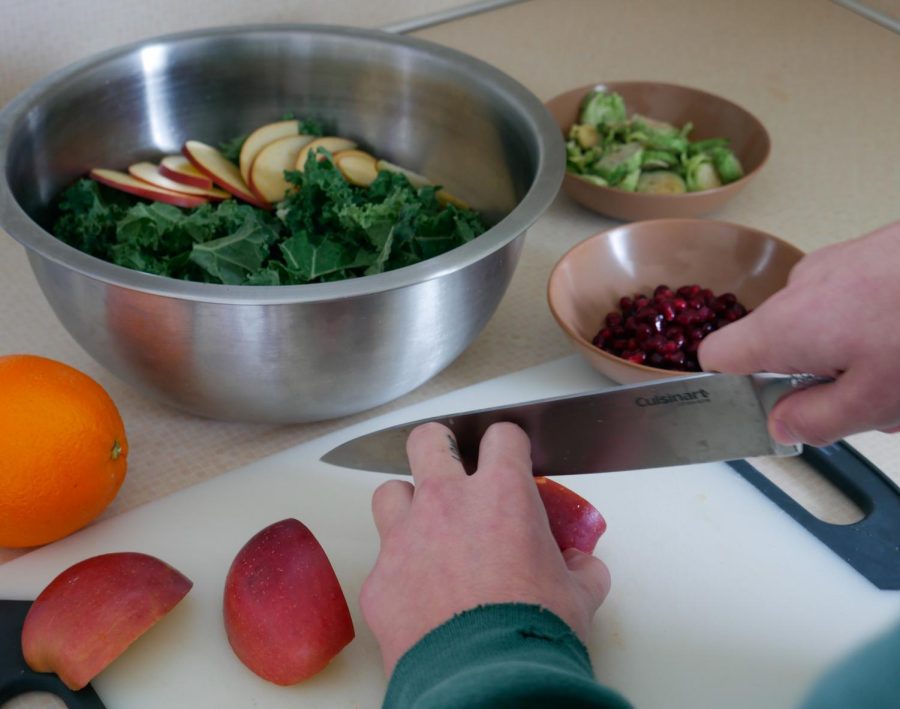Malick: Eating seasonally is in
January 20, 2021
Editor’s Note: This column does not represent the opinion of The Daily Barometer. This column reflects the personal opinions of the writer.
Eating seasonally is the practice of eating foods that are in season. Along with being mindful of where your food comes from, reducing your carbon footprints and taking time to practice prioritizing mental health are three sound changes to make for 2021.
The benefits of eating seasonally lie primarily in eating sustainably. For those who live in Oregon, foods in season in January include apples, winter squash, beets, potatoes, leeks and kale. FoodPrint.org has a free online Seasonal Food Guide and a free app that tracks what foods are in season in your area.
It is a common misconception that eating seasonally and eating locally reduces the output of greenhouse gasses because the food does not have to travel as far.
According to scientific studies published by Cambridge Press by Jennie Macdiarmid and Gareth Edwards-Jones, the emission of greenhouse gases aren’t necessarily lowered by eating seasonally or locally. This is because the main source of greenhouse gasses, according to Macdiarmid and Edwards-Jones, are production and storage. This is, in part, due to the chemistry of the soil.
When produce is grown in season, the plants don’t have to work as hard to survive and bear fruit. Farmers don’t have to use as many agrochemicals to cultivate plants.
According to Patrick Monroe, assistant produce manager at the First Alternative Natural Foods Co-op on Northwest Grant Avenue in Corvallis, Ore., produce grown in season also tastes better.
“For me, eating seasonally flat out is more enjoyable and tastes better—fruit in particular,” Monroe said.
In addition to taste, eating seasonally is a good way of practicing mindfulness. Dr. Michele Ribeiro defines Mindfulness as, “basically present moment awareness, nonjudgmentally. It’s being present with what is. The other piece is accepting the reality as it is.”
Ribeiro that eating seasonally is a method of mindfulness, as accepting what we have available to us is a part of mindfulness. For those interested in practicing mindfulness with Ribeiro, she is offering free drop-in mindfulness sessions on Wednesdays at noon. Anyone interested should email her at [email protected].
Ribeiro went on to point out that as we eat seasonally and are mindful of the food we are eating, we are also mindful of where our food has come from. We think about the people and places our food has come from.
When it comes to learning how to eat sustainably, Monroe points to the people our food comes from.
“Honestly, asking the person selling it to you what’s in season can be the most useful resource, whether that be at the co-op or any big box stores,” Monroe said. “Farmers markets are an excellent place to understand seasonality, but I understand for some it can seem “out of their budget” which I completely respect. [. . .] At the end of the day, Google is a great resource; print up a seasonality calendar and try to only buy what’s in season,” Monroe said.
Eating seasonally works very well with eating locally. Monroe explained that First Alternative sources “as much product as possible as locally as possible.”
Tara Sanders, assistant director of Nutrition and Sustainability at Oregon State University, said the food for the OSU Corvallis campus is sourced from over 40 vendors, about half of which are small, local vendors. A list of some such vendors can be found here.
“10% or more of our food purchases have third-party certifications including Organic, Fair Trade, Rain Forest Alliance, Animal Welfare Approved, Salmon Safe Certified, Food Alliance Certified and Seafood Watch,” Sanders said.
Monroe suggested four dishes, one for each season, to try with seasonal produce. “Prior to working in retail I was a chef for 10 years and went to a four year Culinary School in New York.”
For winter, Monroe recommended citrus and winter greens. Kale, chard and collard greens braised with citrus “goes on everything, toast for breakfast, savory bread pudding, sandwiches, pizza, pasta etc.”
These dark, winter greens are also high in iron, which is especially important during winter to help ward off iron deficiency and anemia. A study published by the American Physiological Society in 1984 found that individuals with low iron and low hemoglobin levels experienced greater changes in temperature when exposed to cold.
For spring, Monroe sang the praises of alliums, such as garlic and onions. “Often overlooked, young overwintered alliums are one of my favorite spring time treats. Planted in late winter and early fall, they sit in the ground and sweeten all winter to then be harvested in spring with wonderful sweetness and mild flavor, compared to their dried cousins.”
In summer, the obvious choice was cherries. “I would say my favorite summer time treat is a cherry float,” Monroe said. He put particular emphasis on Rainier Cherries, which were developed right here in the Pacifc Northwest, at Washington State University in 1952.
Finally, in fall, Monroe said apples were the way to go. “Apples in salad, with a bowl full of the last of the summer greens in my garden is for sure a highlight for me. With some added cheese and seasonally harvested toasted hazelnuts I pretty much am in fall heaven,” Monroe said.
On OSU’s campus, Sanders said University Housing and Dining Services have been running the Harvest of the Month program for over 10 years. This program has been put on hold due to COVID-19.
Sanders also added, “[We] are in a much more steady place and I do think this is something we could re-integrate and I really appreciate the nudge to look at this!” The Harvest of the Month program will return for the spring term in 2021.











































































































